Today, lighting is an essential part of the interior design of a house or apartment. Therefore, it is very important that the chosen lighting device gives the required level of lighting in the room. But besides this, it is necessary to take into account the possible harm to health that a selected light source can cause during its operation.
In many homes at this time, as a source daylight fluorescent light bulbs are widely used.
In this article we will touch on the question of how serious the damage to fluorescent lamps is to the human body.
One of the lighting leaders
Fluorescent light bulbs in modern apartments and houses today are very actively used to create primary or secondary lighting. This is due to the fact that such sources of daylight have the following advantages:
- significant energy savings;
Note! Energy savings when using fluorescent lamps is about 80%.
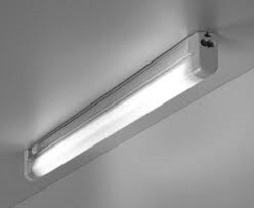
Light bulb in action
- quality and durability. The service life of such light sources is 10-12 times longer than an ordinary incandescent lamp. Thus, the benefits are obvious - once you buy such a light bulb, you will forget about the need to buy a new one for about ten years;
- sufficiently high parameters of the emitted light.
As you can see, the presence of such advantages in the operation of fluorescent lamps allows them to be among the most common light sources. The real benefits of their use will be noticeable almost immediately.
Obvious cons
Despite the fact that fluorescent lamps have a good set of advantages, the use of such daylight sources at home also has a lot of disadvantages. However, many of them can lead to a deterioration in human health.
Here it should be separately mentioned that the cost of such bulbs is quite high. This is a minus in the next place after the harm that such products can cause to the human body.
The negative aspects of the operation of fluorescent lamps include:

Dermatitis
- the presence of ultraviolet radiation. With such bulbs, people with various skin diseases should be very careful. Otherwise, dermatitis, eczema, pigmentation, psoriasis, etc. may occur. In critical cases, skin cancer may even begin. But to get so negative consequences, the light source must be used for a very long time;
- secondary aspects of the work - flicker or strobe effect. This is another significant disadvantage in the operation of fluorescent lamps, which directly affects the visual system. The speed of blinking of such a light bulb can reach 50 times per second. Such flickering is very painful to the eyes. They begin to water, visual acuity decreases and overall eye fatigue increases. Also, flickering can lead to distortion of the visual perception of objects;
Note! Flicker can be corrected by installing 2 or more products in the lamp. This will reduce visual discomfort and reduce damage caused by the eyes.
- lack of inertia. As a result, these bulbs are lit with a slight delay. It can also cause visual discomfort. In this situation, the eye muscles are trying to adjust the lens to the changing light / dark criterion and can not always cope with this effectively.
Note! All of the above negative points will not help even the observance of all rules for the operation of the product. This will only minimize the harm, but completely eliminate it still does not work.
The work of such bulbs is especially dangerous for small children, whose visual system is at the stage of development. After a year of being under such a light source, children are diagnosed with reduced visual acuity and may even need glasses.
What else do you need to know
It is worth noting that mercury is included in the fluorescent light sources, albeit in small quantities. The average mercury content in one light bulb is about 3-5 g. It is needed in order to prevent incandescence of the bulb and transmit excitation through the lamp.
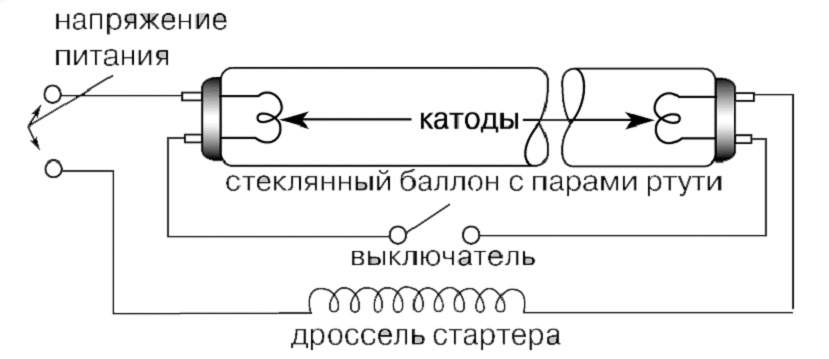
Light bulb structure
The presence of mercury makes such a luminaire very dangerous in the event that the lamp was broken. After all, as you know, mercury accumulates in the human body and is not derived from it. Subsequently, it can stimulate the appearance of not only certain health disorders, but also the development of chronic diseases.
Especially negatively this situation affects the children's body. If on an adult person the ingress of mercury inside the body does not affect so much, then in a child the manifestations of deterioration in health will begin immediately.
In case of damage to the flask of the product, it is imperative to carry out the procedure of de-cyclization (clean the room from mercury).
In addition, due to the presence of mercury in the lighting device, its utilization is significantly complicated. These light bulbs can not just take and throw in the trash. For their disposal there are special points of reception.
Not so light
In the negative impact on human health of fluorescent lamps, the linear spectrum of light plays an important role. Our eyes are accustomed in the process of evolution to the continuous spectrum of the sun. This spectrum is successfully copied by an ordinary incandescent bulb. But fluorescent products lack a part of the spectrum, which naturally adversely affects the human visual system.
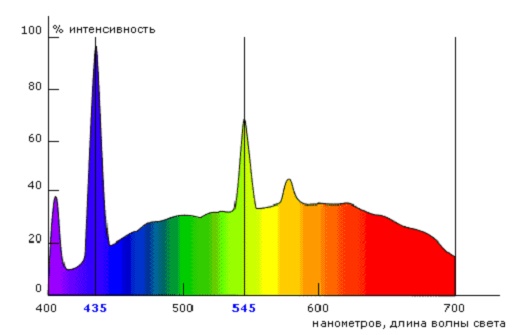
Glow spectrum
From such illumination, eyes will get tired much faster, tearfulness will appear. With a long and constant stay under such a light source, visual acuity is unambiguously reduced.
In addition, the glow of fluorescent lamps has another negative effect - the distortion of reality. Under such illumination, moving objects may appear motionless. This is especially true for small objects: drills, fans, etc.
This situation is fraught with numerous injuries, especially if small children live in the house.
Another point in favor of the harm of such a light source is the creation of an electromagnetic radiation lamp. The approximate range of his work covers a meter radius. Therefore, this type of light bulbs should not be used near your favorite place in the room. Otherwise, you will have a headache, indigestion, sleep disturbance and other manifestations of indisposition.
People who are often exposed to fluorescent light are diagnosed with a decrease in melatonin levels. And this can already lead to disruption of the biological rhythms of the body and malfunction of almost all internal organs.
As you can see, fluorescent lamps have an impressive set of negative features of their work, which lead to the disruption of many systems in the human body. If for places of public use where a person does not stay permanently, such lamps are suitable, then for an apartment or house it will not be the most good decision. No amount of advantages of these devices can compensate for the harm done to a person!
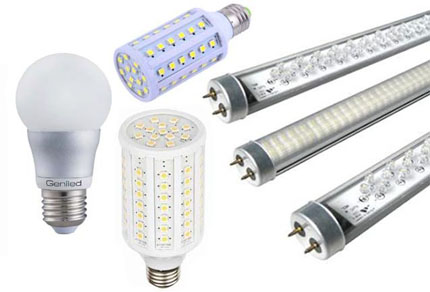 Secrets of choice lED bulbs for home
Secrets of choice lED bulbs for home
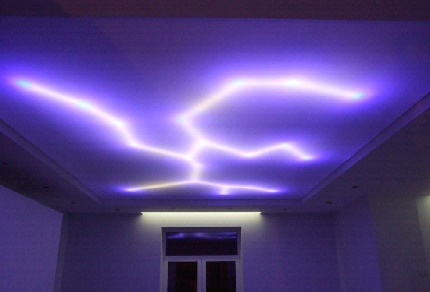 LED strip - what you need to know when choosing
LED strip - what you need to know when choosing
Fluorescent Lamp
Different types of fluorescent lamps
Fluorescent Lamp - gas-discharge light, in which visible light is emitted mainly by the phosphor, which, in turn, glows under the influence of ultraviolet radiation discharge; The discharge itself also emits visible light, but to a much lesser extent.
Advantages and disadvantages
The popularity of fluorescent lamps due to their advantages (above incandescent lamps):
The disadvantages include:
- the presence of additional devices for starting the lamp - control gear (bulky noisy choke with unreliable starter or electronic ballast);
- flicker of the lamp with the frequency of the mains (leveled by the use of electronic ballasts)
- a failed starter causes a false start of the lamp (several flashes are visually detected before a stable ignition), reducing the life of the filaments;
- very low power factor of the lamps - such lamps are unsuccessful for the power grid;
Story
The first ancestor of the fluorescent lamp were discharge lamps. For the first time the glow of gases under the influence of electric current Mikhail Lomonosov observed, passing a current through a glass ball filled with hydrogen. It is believed that the first discharge lamp was invented in 1856. Heinrich Geissler received a blue glow from the gas-filled tube, which was excited using a solenoid. On June 23, 1891, Nikola Tesla patented the electric lighting system with gas-discharge lamps (patent No. 454,622), which consisted of a high-frequency source of high frequency and gas-discharge argon lamps patented by them earlier (patent No. 335,787 of February 9, 1886 issued by the United States Patent Office). Argon lamps are in use today. In 1893, at the World's Fair in Chicago, Illinois, Thomas Edison showed a luminous glow. In 1894, MF Moore created a lamp in which he used nitrogen and carbon dioxide, emitting pink-white light. This lamp had a moderate success. In 1901, Peter Cooper Hewitt demonstrated a mercury lamp that emitted blue-green light, and thus was unsuitable for practical purposes. However, its design was very close to modern, and had much higher efficiency than Geissler and Edison lamps. In 1926, Edmund Germer and his collaborators proposed to increase the operating pressure within the bulb and cover the flasks with a fluorescent powder that converts the ultraviolet light emitted by the excited plasma into more uniform white-colored light. E. Germer is currently recognized as the inventor of fluorescent lamps. General Electric later bought a Germer patent, and, under the leadership of George E. Inman, brought the fluorescent lamps to widespread commercial use by 1938. In the USSR, the first fluorescent lamps were developed under the leadership of Academician S. I. Vavilov, V. A. Fabrikant, F. A. Butaeva, and others.
Principle of operation
When a fluorescent lamp is operated, a glow discharge occurs between two electrodes located at opposite ends of the lamp. The lamp is filled with inert gas and mercury vapor, the current flowing leads to the appearance of UV radiation. This radiation is invisible to the human eye, so it is converted into visible light using the luminescence phenomenon. The inner walls of the lamp are coated with a special substance - a phosphor that absorbs UV radiation and emits visible light. By changing the composition of the phosphor, you can change the shade of the glow of the lamp. Calcium halophosphates and calcium-zinc orthophosphates are mainly used as luminophores.
Marking
The three-digit code on the lamp packaging usually contains information on the quality of light (color rendering index and color temperature).
The first digit is the color rendition index of 1x10 Ra (compact fluorescent lamps have 60-98 Ra, so the higher the index, the more reliable the color rendition)
The second and third digits indicate the color temperature of the lamp.
Thus, the “827” marking indicates the color rendering index at 80 Ra, and the color temperature at 2700 (which corresponds to the color temperature of the incandescent lamp)
In addition, the color rendering index may be designated in accordance with DIN 5035, where the color rendering range of 20-100 Ra is divided into 6 parts, from 4 to 1A. (him)
Features of perception
The color perception of a person varies greatly depending on the brightness. With a small brightness, we see better blue and worse red. therefore colour temperature daylight (5000-6500K) in low light conditions will appear excessively blue. The average illumination of residential premises is 75 lux, while in offices and other workrooms it is 400 lux. With a small brightness (50-75 lux), the most natural is light with a temperature of 3000K. With a brightness of 400 lux, such light already appears yellow, and the most natural seems to be light with a temperature of 4000-6000K.
International marking for color and color temperature
| Code | Definition | Special features | Application |
|---|---|---|---|
| 530 | Basic warmweiß / warm white | Light warm tones with poor color reproduction. Objects appear brownish and low contrast. Mediocre light output. | Garages, kitchens. Recently meets less and less. |
| 640/740 | Basic neutralweiß / cool white | "Cool" light with mediocre color and light output | Very common, must be replaced with 840 |
| 765 | Basic Tageslicht / daylight | Bluish "daylight" with mediocre color and light output | It is found in office space and for illuminating advertising structures (citylights) |
| 827 | Lumilux interna | Similar to incandescent light with good color and light output | Housing |
| 830 | Lumilux warmweiß / warm white | Like the light halogen lamp with good color and light output | Housing |
| 840 | Lumilux neutralweiß / cool white | White light for work surfaces with very good color rendering and light output | Public places, offices, bathrooms, kitchens. Exterior lighting |
| 865 | Lumilux tageslicht / daylight | "Day" light with good color and mediocre light output | Public places, offices. Exterior lighting |
| 880 | Lumilux skywhite | "Day" light with good color | Exterior lighting |
| 930 | Lumilux Deluxe warmweiß / warm white | “Warm” light with excellent color rendering and poor light output | Housing |
| 940 | Lumilux Deluxe neutralweiß / cool white | “Cold” light with excellent color rendering and mediocre light output. | Museums, exhibition halls |
| 954, 965 | Lumilux Deluxe Tageslicht / daylight | "Day" light with a continuous range of color and mediocre light output | Showrooms, aquarium lighting |
Color marking in accordance with GOST 6825-91 *
![]()
Fluorescent lamp manufactured in the USSR with a power of 20 W ("LD-20"). Foreign analog of this lamp - TLD 20W
In accordance with GOST 6825-91 * (IEC 81-84) "Tube-luminescent lamps for general lighting", acting, linear-purpose luminescent lamps of general purpose are marked as:
- Lb (white light)
- LD (daylight)
- LE (natural light)
- LHB (cold light)
- LTP (warm light)
The addition of the letter C at the end means the use of a “de-lux” phosphor with improved color rendition, and a CC with a “de-lux” phosphor with high-quality color rendition.
Special-purpose lamps are marked as:
The parameters of bulbs produced in the USSR for color reproduction are shown in the table:
| Abbreviation | Decryption | Tint | Color temperature, K | Purpose | Color rendition | Approximate equivalent for international labeling |
|---|---|---|---|---|---|---|
| Fluorescent lights | ||||||
| LDC, LDCC | Fluorescent lamps, with improved color reproduction; LDC - de luxe, LDCC - super deluxe | White with a light bluish tint and relatively low light output | 6500 | For museums, exhibitions, in photography, in industrial and administrative premises with increased requirements for color reproduction, educational institutions, residential premises | Good (LDC), excellent (LDCC) | 865 (LDC), 965 (LDCC) |
| LD | Fluorescent lights | White with a light bluish tint and high light output | 6500 | In production and administrative premises without high requirements to a color rendition | Acceptable | 765 |
| Natural light bulbs | ||||||
| LETS, LETS | Lamps of natural light, with improved color reproduction; LETS - de luxe, LETZ - super deluxe | Sunny white with relatively low light output | 4000 | For museums, exhibitions, in photography, in educational institutions, residential premises | Acceptable (LEC), good (LEC) | 754 (LEC), 854 (LEC) |
| LU | Natural light bulbs | White without shade and high light output | 4000 | Unsatisfactory | 640 | |
| Other lighting lamps | ||||||
| Lb | White light bulbs | White with a mauve tint, poor color reproduction and high light output | 3500 | In rooms where bright light is needed and color rendition is not required: production and administrative premises, in the metro | Unsatisfactory | 635 |
| LHB | Cold white light bulbs | White with a noticeable blue tint | 4850 | Unsatisfactory | 685 | |
| LTP | Warm White Bulbs | White with a warm pink shade to illuminate rooms rich in white and pink tones | 2700 | In food stores, catering | Relatively acceptable for warm tones, unsatisfactory for cold | 530, 630 |
| Ltbts | Lamps of warm white light with the improved color rendition | White with a warm pink shade | 2700 | The same as for LTP, as well as for residential premises. | Acceptable for warm tones, less satisfactory for cold | 730 |
| Special purpose lamps | ||||||
| LH, LC, LZ, LV, LR, LGR | Lamps with color phosphor | LH - blue, LC - red, LZ - green LV - yellow, LR - pink, LGR - Purple |
- | For light design, artistic lighting of buildings, signs, shop windows | - | LG: 67, 18, BLUE LC: 60, 15, RED LZ: 66, 17, GREEN LV: 62, 16, YELLOW |
| LSR | Blue reflector lamps | Bright blue light bulbs | - | In electrophotographic copiers | - | - |
| LUF | UV lamps | Lamps of dark blue light with a pronounced ultraviolet component | - | For night illumination and disinfection in medical institutions, barracks, etc., as well as “black light” for light design in nightclubs, discotheques, etc. | - | 08 |
Connection Features

Cheap electronic connection option
A fluorescent lamp, unlike an incandescent lamp, cannot be switched directly into electrical network. There are two reasons for this:
- To ignite the arc in a fluorescent lamp requires a high voltage pulse.
- Fluorescent lamp has a negative differential resistance, after ignition of the lamp current in it increases many times. If it is not limited, the lamp will fail.
To solve these problems use special devices - ballasts. The most common schemes today are electromagnetic ballast with a neon starter and various types of electronic ballasts.
Electromagnetic Ballast
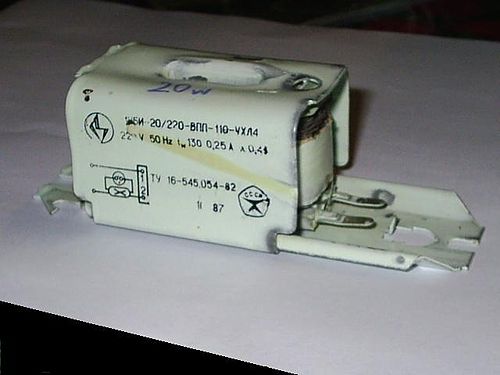
Electromagnetic ballast "1UBI20" series 110 of the plant BATRA, USSR.
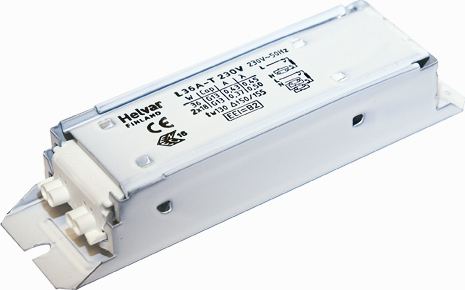
Modern Electromagnetic Ballast "L36A-T" plant Helvar, Finland.
Electromagnetic Ballast It is an electromagnetic choke connected in series with the lamp. A starter is connected in series to the lamp filaments. neon lamp with bimetallic electrodes and a capacitor. The choke forms a triggering pulse due to self-induction, and also limits the current through the lamp. Currently, the advantages of electromagnetic ballast are simplicity of design, reliability and low cost. There are a lot of disadvantages of such a scheme:
- Long start (1-3 seconds, depending on the degree of wear of the lamp);
- More power consumption than the electronic circuit - at a voltage of 220 volt, a luminaire 2 of 58 watts = 116 watts consumes 130 watts;
- Small cos φ = 0.5 (without compensating capacitors);
- Low frequency hum (100 Hz) coming from the choke, increasing with the aging of the choke;
- Flickering of a lamp with a doubled frequency of the network, which can damage eyesight, and sometimes it is dangerous (due to the stroboscopic effect, objects rotating synchronously with the frequency of the network may appear fixed. Therefore, fluorescent lamps with electromagnetic ballast are not recommended for lighting moving parts of machines and mechanisms);
- Large dimensions and weight;
- At temperatures below 10 ° C, the lamp brightness is significantly reduced due to a decrease in the gas pressure in the lamp;
- At negative temperatures, the lamps according to the classical scheme may not light up at all; under these conditions, autotransformers are used.
Electronic ballast
Electronic ballast It supplies a voltage to the electrodes of the lamp not at the frequency of the network, but at high frequency (25-133 kHz), as a result of which blinking of the lamps noticeable to the eyes is excluded. However, high-frequency oscillations, passing through the lamp as an antenna, create electromagnetic interference in a wide spectrum, therefore the RF radio frequency range - long waves, starting from 150 kHz, became unsuitable for use, but argued that it was unprofitable to build large antennas and switched to VHF range, the waves of which propagate only within the direct line of sight and need repeater repeaters.
One of two options for starting the lamps can be used:
- Cold start - at the same time the lamp lights up immediately after switching on. This scheme is better to use if the lamp is turned on and off rarely, since the cold start mode is more harmful to the electrodes of the lamp.
- Hot start - with preheating of the electrodes. The lamp does not light up immediately, but after 0.5-1 sec, but the service life increases, especially with frequent switching on and off.
Electricity consumption by fluorescent lamps when using electronic ballast is usually 20-25% lower. Material costs (copper, iron) for the manufacture and utilization of less than several times. The use of centralized lighting systems with automatic adjustment can save up to 85% of electricity. There are electronic ballasts with the possibility of dimming (dimming) by changing the duty cycle of the lamp supply current.
Starting lamp with electromagnetic ballast
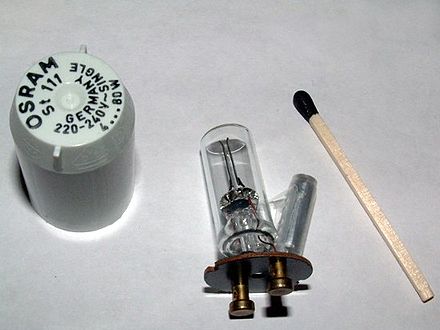
In the classical circuit with electromagnetic ballast for automatic control The ignition process of the lamp is applied starter (starter), which is a miniature discharge lamp, usually neon. One starter electrode is fixed rigid, the other is bimetallic, bending when heated. There are also starters with two flexible electrodes (symmetric). In the initial state, the starter electrodes are open. The starter is connected parallel to the lamp so that when its electrodes are closed, the current passes through the spirals of the lamp.
At the moment of switching on, the full voltage of the network is applied to the electrodes of the lamp and the starter, since the current through the lamp is absent and the voltage drop at the choke is zero. The electrodes of the lamp are cold, there is no discharge, and the voltage of the network is not enough for its ignition. But in the starter from the applied voltage there is a glow discharge, and the current passes through the electrodes of the lamp and the starter. The discharge current is small to heat the electrodes of the lamp, but sufficient to heat the electrodes of the starter, causing the bimetallic plate to bend and close with a hard electrode. Current flows through the electrodes of the lamp and heats them. When the starter electrodes cool down, the circuit is opened, and due to self-induction, a voltage surge is applied to the choke, which is necessary for igniting the discharge. Parallel to the starter, a miniature capacitor of a small capacitance is connected, which serves to provide the condition for the occurrence of current resonance together with the inductor and, as a result, the ignition of the lamp. In the absence of a capacitor, this pulse will be too short and the amplitude too large, and the energy accumulated in the choke will be used up for discharge in the starter. By the time the starter opens, the lamp electrodes are already sufficiently heated, but not all of the mercury in the lamp has evaporated and the discharge takes place in an argon atmosphere, due to which the discharge in the lamp is unstable and the starting process can be repeated several times. As soon as all the mercury in the lamp flask evaporates in sufficient quantity, the lamp enters the operating mode.
The operating voltage of the lamp is lower than the mains voltage due to the voltage drop across the choke, therefore, the starter does not reactivate again. In the process of igniting the lamp, the starter sometimes triggers several times in a row if it opens at the moment when the instantaneous value of the choke current is zero or the lamp electrodes are not heated enough. As wear deteriorates, the operating voltage increases, the number of starter response cycles increases, and in the end the lamp can no longer enter operating mode. This causes the characteristic blinking of a failed lamp. When the lamp goes out, you can see the glow of the cathodes, heated by the current flowing through the starter.
Starting lamp with electronic ballast
Unlike electromagnetic ballast, an electronic special ballast usually does not require a separate special starter, since such a ballast is generally able to form the necessary voltage sequences itself. There are various ways to start fluorescent lamps. Most often, the electronic ballast heats the cathodes of the lamps and applies voltage to the cathodes sufficient to ignite the lamp, usually alternating and of higher frequency than the network one (which also eliminates the flickering of the lamp characteristic of electromagnetic ballasts). Depending on the design of the ballast and the timing of the lamp start-up sequence, such ballasts can provide, for example, a smooth start of the lamp with a gradual increase in brightness to full in a few seconds, or an instantaneous switching on of the lamp. Often there are combined start-up methods, when the lamp is started not only due to the fact that the cathodes of the lamp are heated, but also due to the fact that the circuit in which the lamp is connected is an oscillating circuit. The parameters of the oscillating circuit are selected so that in the absence of a discharge in the lamp in the circuit, the phenomenon of electrical resonance occurs, leading to a significant increase in voltage between the cathodes of the lamp. As a rule, this also leads to an increase in the heating current of the cathodes, since with such a scheme of starting the heating coil, the cathodes are often connected in series through a capacitor, being part of an oscillatory circuit. As a result, due to the preheating of the cathodes and the relatively high voltage between the cathodes, the lamp is easily ignited. After ignition of the lamp, the parameters of the oscillating circuit change, the Q-factor decreases and the current in the circuit drops significantly, reducing the heating of the cathodes. There are variations of this technology. For example, in the limiting case, the ballast may not warm up the cathodes at all, instead, by applying enough high voltage cathodes, which will inevitably lead to almost instantaneous ignition of the lamp due to gas breakdown between the cathodes. In essence, this method is similar to the technology used to start cold cathode tubes (CCFL). This method is quite popular with radio amateurs, because it allows even lamps with blown filaments of cathodes to be launched, which cannot be started by conventional methods due to the impossibility of heating cathodes. In particular, this method is often used by amateurs for the repair of compact energy saving lampswhich are ordinary fluorescent lamps with built-in electronic ballast in a compact package. After a slight rework of the ballast, such a lamp can still serve for a long time, despite the heating of the heating coils, and its service life will be limited only by the time until the electrodes are completely sprayed.
Reasons for failure
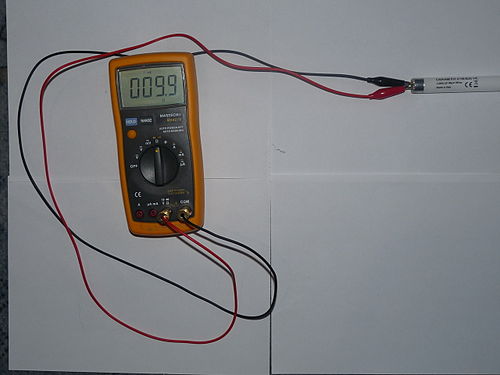
Check the electrodes on one side for integrity. The resistance of 9.9Ω indicates that the electrode filament on this side is intact.
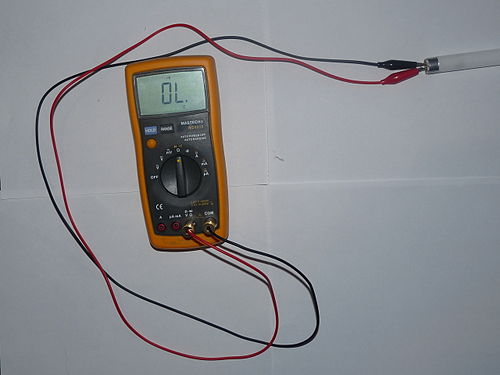
Check the electrodes on one side for integrity. Infinitely large resistance suggests that the thread of the electrodes is broken. The second sign is darkening near the electrode.
The electrodes of the fluorescent lamp are tungsten filaments coated with a paste (active mass) of alkaline earth metals. This paste also provides a stable discharge and protects tungsten filaments from overheating. In the process of work, it gradually crumbles from the electrodes, burns and evaporates. Especially intensively, it crumbles during start-up, when for some time the discharge occurs not over the entire area of the electrode, but on a small portion of its surface, which leads to local temperature differences. Therefore, fluorescent lamps still have a finite service life (it depends mainly on the quality of manufacture of the electrodes, the speed of ignition), although it is longer than that of conventional lamps incandescent, in which a spiral with a constant speed evaporates. From here darkening on the ends of a lamp which amplifies closer to the termination of service life. When the paste burns out completely, the lamp current begins to fall, and the voltage increases accordingly.
Failure of lamps with electromagnetic ballast
Increasing the voltage on the lamp in the process of aging leads to the fact that the starter starts to constantly work - hence the well-known blinking of the failed lamps. In this case, the electrodes of the lamp are constantly heated, and in the end (after about 2 to 3 days of blinking) one of the filaments burns out. Then a minute or two of the lamp is lit without flickering, the discharge comes from the remnants of a burned-out electrode, on which there is no alkaline-earth metal paste, only tungsten remains. These remnants of the tungsten filament are heated very strongly, because of which they partially evaporate or fall off, after which the discharge goes to the traverse (the wire to which the tungsten filament with the active mass is attached), it partially melts and the lamp begins to flicker again. If you turn it off, it will no longer light up. At the same time, due to long continuous operation, the starter often fails, so that when the lamp is replaced it is necessary to change it as well. If the starter fails due to poor quality (short circuit of bimetallic contacts or capacitor breakdown), the lamp electrodes are heated and burn out after a few days. When the throttle is broken, the lamp burns instantly.
Failure of electronic ballast lamps
In the process of aging, the lamp gradually burns out the active mass of the electrodes, after which the filaments are heated and burn out. In high-quality ballasts, a scheme of automatic shutdown of a burnt-out lamp is provided. In low-quality electronic ballasts, there is no such protection, and after the voltage is increased, the lamp will go out, and a resonance will occur in the circuit, leading to a significant increase in current and the ballast transistors will burn out.
It is also common for poor quality ballasts (usually on compact fluorescent lamps with built-in ballast) at the output to set a capacitor designed for a voltage close to the operating voltage of the new lamp. As the lamp ages, the voltage rises and a breakdown occurs in the capacitor, which also disrupts the ballast transistors.
When a lamp with electronic ballast fails, flicker, as in the case of electromagnetic ballast, is absent, the lamp goes out immediately. You can determine the cause of failure by checking the integrity of the lamp threads with any ohmmeter, multimeter, or specialized device for testing lamps. If the lamp filaments have low resistance (about 10 ohms, that is, they have not burned out), then the reason for failure is low quality of ballast, if one or both of the filaments have high (infinite) resistance, then the lamp has burnt out due to old age or overvoltage. In the latter case, it makes sense to try to replace the lamp itself, however, if the new lamp also does not glow and the power supply of the ballast is present, then this also indicates a low quality of ballast (there is a risk of spoiling the new lamp).
Phosphors and emitted light spectrum
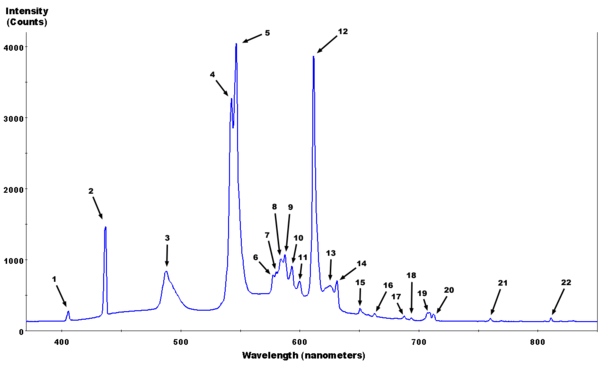
Typical fluorescent lamp spectrum.
Many people find the light emitted by fluorescent lamps rude and unpleasant. The color of objects illuminated by such lamps may be somewhat distorted. This is partly due to the blue and green lines in the emission spectrum of a gas discharge in mercury vapor, partly due to the type of phosphor used, and partly from the wrong lamp used for warehouses and non-residential premises.
Many cheap lamps use a halophosphate phosphor, which emits mostly yellow and blue light, while less red and green light is emitted. Such a mixture of colors to the eye appears white, but when reflected from objects, light may contain an incomplete spectrum, which is perceived as a color distortion. However, such lamps, as a rule, have a very high luminous efficiency.
If we consider that in the human eye there are three types of color receptors, and the perception of a continuous spectrum is only the result of the brain, then there is no need to recreate a continuous solar spectrum, it is enough to recreate the same effect on these three receptors. This principle has long been used in color television and color photography. Therefore, in the more expensive lamps, a “three-band” and “five-band” phosphor is used. This makes it possible to achieve a more uniform distribution of radiation over the visible spectrum, which leads to a more natural reproduction of light. However, such lamps, as a rule, have less luminous efficiency.
Flasks of special lamps are made of UV glass that transmits rays in the ultraviolet wavelength range.
At home, the spectrum of the lamp can be estimated using a CD. To do this, look at the reflection of the light of the lamp from the working surface of the disk - in the diffraction pattern the spectral lines of the phosphor will be visible. If the lamp is close, it is better to place a screen with a small hole between the lamp and the disk.
Special fluorescent lamps
There are also special fluorescent lamps with different spectral characteristics:
- Fluorescent lamps that meet the highest requirements for natural color reproduction when daylight 5400K, serve to eliminate the effect of color mimicry. It is indispensable in cases where the atmosphere of living daylight is needed, for example, in printing houses, art galleries, museums, dental offices, and laboratories, when viewing transparencies and in specialized stores of textile goods.
- Fluorescent lamps that emit light, which in its spectral characteristics is similar to sunlight. These lamps are recommended for rooms with a lack of daylight, for example, for offices, banks and shops. Due to its very good color rendering and high color temperature (6500K), it is ideal for comparing paints and medical light therapy.
- Fluorescent lamps for plants and aquariums with enhanced radiation in the spectral range of blue and red light. Ideally affects photobiological processes. These lamps with designations emit light with a minimum content of the UV component of type A (in the absolute absence of ultraviolet components of type B and C). Usually combined with fluorescent lamps (5400K - 6700K), to give a natural background lighting.
- Lamps for marine inhabitants of aquariums with radiation in the range of blue and ultraviolet. They serve to impart a natural coloring to corals and coral reef inhabitants. Also, these lamps allow some species of coral to fluoresce, which in turn “animates” the composition. Usually combined with fluorescent lamps (5400K - 6700K), to give a natural background lighting.
- Decorative lamps of red, yellow, green, blue and crimson colors. Colored fluorescent lamps are particularly suitable for decorative lighting and to create special lighting effects. The color of the lamp is obtained by using a special phosphor or by coloring the flask. In addition, the yellow fluorescent lamp does not contain an ultraviolet component in its spectrum. Therefore, this lamp is recommended for sterile production, for example, for workshops for the manufacture of microchips (photoresists are used in such production - substances that react with UV), as well as for general illumination without UV radiation.
- Fluorescent lamps designed to illuminate the premises, which contain birds. The spectrum of these lamps contains the near ultraviolet, which allows you to create more comfortable for them lighting, bringing it closer to natural, as birds, unlike people, have four-component vision.
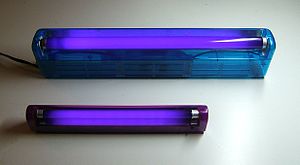
Lamps from the lamps of "black" light
- Lamps with special color characteristics:
- varnishes, paints to a depth of no more than 1 mm; treatment of hyperbilirubinemia.
- for polymerization of plastics, adhesives, varnishes, paints to a depth of more than 1 mm; psoriasis treatment; attracting insects to insect traps; for the recognition of fakes.
Execution options
Fluorescent lamps - low-pressure discharge lamps - are divided into linear and compact.
Linear lamps
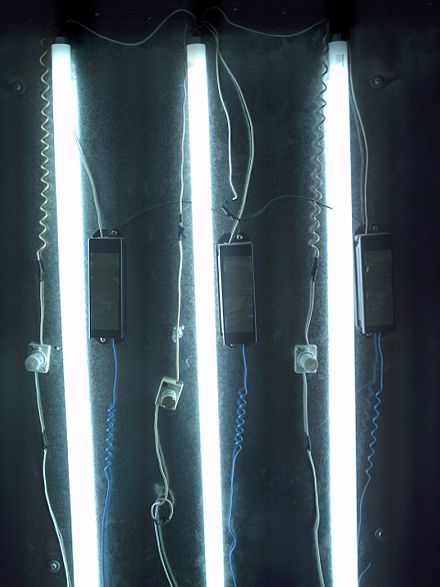
Linear fluorescent lamp - low-pressure mercury lamp direct, ring or U-shaped, in which most of light is emitted by a luminescent coating excited by ultraviolet radiation discharge. Often, such lamps are completely incorrectly called - lumpy or tubular, such a definition is outdated, although it does not contradict GOST 6825-91, in which the designation "tubular" is adopted.
The two-cap rectilinear fluorescent lamp is a glass tube, at the ends of which the glass legs are welded with electrodes fixed on them (spiral heating wires). On the inner surface of the tube is applied a thin layer of crystalline powder - phosphor. The tube is filled with an inert gas or a mixture of inert gases (Ar, Ne, Kr) and hermetically sealed. A metered amount of mercury is injected inside, which, when the lamp is operating, enters the vapor state. At the ends of the lamp there are bases with contact pins for connecting the lamp to the circuit.
Linear lamps vary by.
Properly selected and properly executed lighting is one of the ways to create a cozy, harmonious and favorable atmosphere. And an important step in this matter is the choice of lighting equipment. One of the best economical, practical and aesthetic options are fluorescent lamps.
The appearance of the lamp luminescent type allows you to destroy the stereotype on the basis of which the lighting fixture is a bulky chandelier attached to the center of the ceiling. Kitchen lighting can be made in different ways: to have an elongated or cylindrical handicap, to include one or many lamps, to be built-in or overhead type.
The structure of the fluorescent lamp
The lamp body is made of sheet steel, the surface of which is coated with a special powder or polymer coating. The luminaire also includes components such as a choke, starters and capacitors, holders and fasteners. For dispersion of a stream of light the raster lattice or "light beams" is used. As for the power indicators, they vary in the range of 6-36 watts.
Taking into account the type of installation, kitchen fluorescent lamps can be classified into the following categories:
- built-in lighting devices are small light bulbs that are mounted on pieces of furniture;
- overhead lamps, such a fluorescent lighting for the kitchen has a maximum light output and compact dimensions. This makes it the best option for placing a small area;
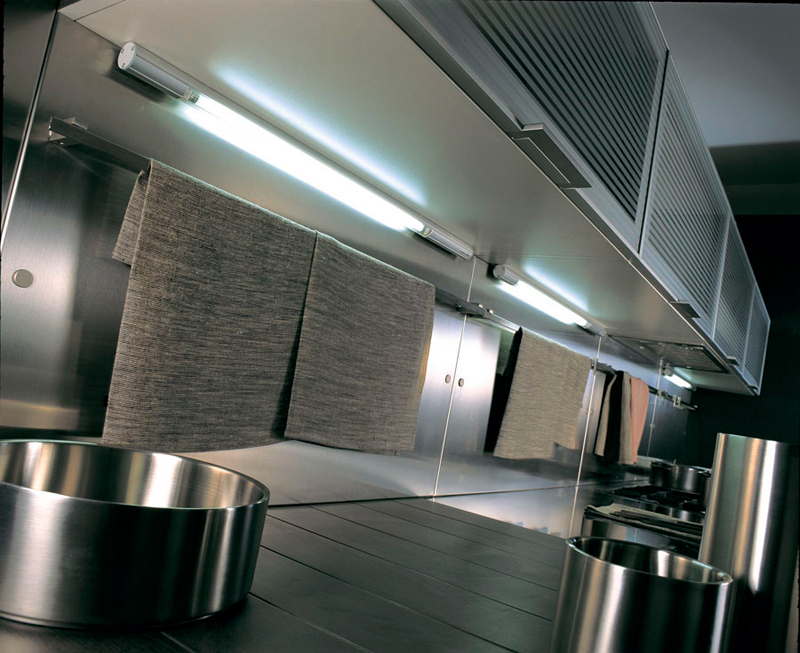
- pendant lights that are ideal for kitchens with high ceilings. To install them, special cables are used that allow you to adjust the height of the lamp;
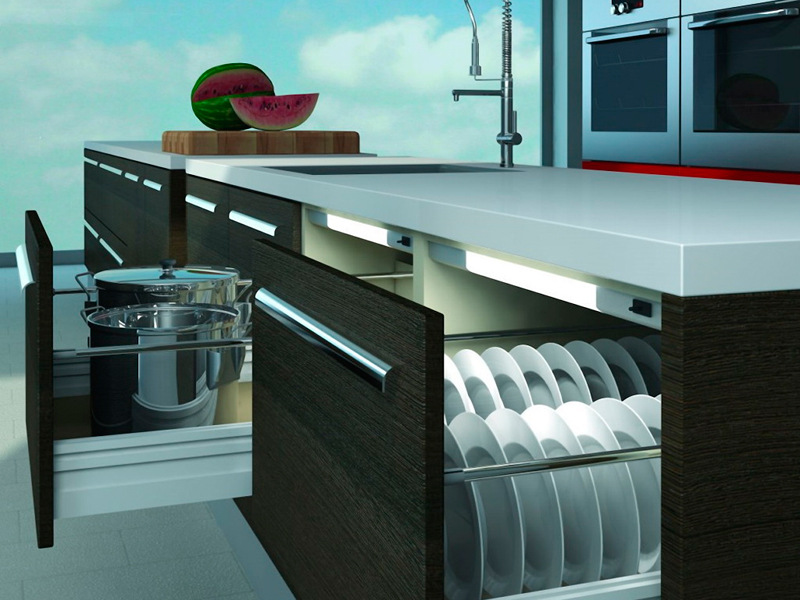
- raster lighting devices that can have very different body shapes. fluorescent raster lighting for the kitchen can be open and closed, static and rotary type, rectangular and square shape, equipped with diffusers or not have them in their design.
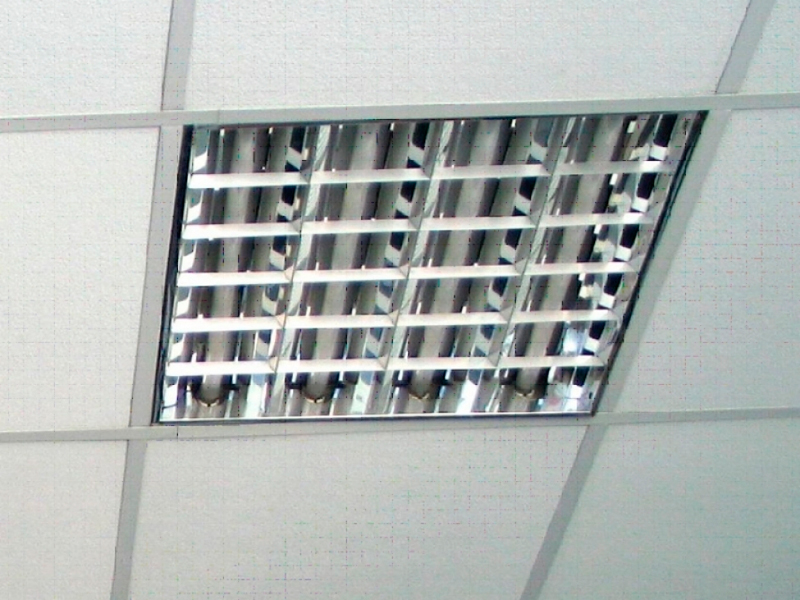
Taking into account the type of connecting fluorescent lamps are divided into the following types:
- transit, to connect them using a serial connection type, when one line is connected to 10 light bulbs. For this, a special adapter is used. A minimum of wires - the main plus of transit fluorescent lighting for the kitchen;
- non-transit, in other words, dead-end lamps, each of which has its own wire and is included in a separate power source.
Another type of fluorescent lamps that have an IP degree of protection is on the market for lighting equipment.
The letter combination “IP” has a two-digit numeric indicator. The first digit measures the degree of protection in the event of ingress of solid particles, the second indicates moisture resistance. The cost of *** IP type fluorescent lighting for the kitchen *** is slightly higher than standard lamps, but it is an ideal practical and durable option for a kitchen room where there is always an unstable level of humidity.
What are the advantages of fluorescent lighting?
In favor of the fluorescent lighting for the kitchen speak many positive characteristics of this type of lamps.
Among them are the advantages:
- Efficiency. To complete the fluorescent lamps used energy-saving type lamps. Due to this, it is possible to reduce the level of energy consumption by up to 80%. This in turn reduces the financial costs of utilities. In this way, lighting fixtures are paid off as soon as possible.
- Brightness. Such lamps shine five times brighter than standard lighting. For a kitchen room, lighting with a uniform, flicker-free, bright luminous flux is considered optimal. Fluorescent lights Meet these requirements and will be the ideal type of lighting. Such lighting does not strain the eyes and convey all the subtleties and features of the kitchen interior.
- Durability. This type of backlight is notable for its uninterrupted and long service life. Their operational period is 10 times higher than the service life of a conventional lamp.
- Versatility. Fluorescent lighting devices can be used both as the main kitchen lighting, and for the formation of designer lighting design. A variety of shapes, types, sizes, power characteristics of these light elements allows you to choose the optimal lighting for any interior, kitchen of any layout and size.
- Easy installation. Installation of fluorescent lighting does not require special knowledge and skills. Without the help of experts, having a standard set of tools, the installation of lamps can be done by hand.
- Availability of models with motion sensors. It is the perfect solution for mobile modern people who value innovation and comfort.
- Low cost. As long as fluorescent lighting devices are only being introduced to the consumer market, the price for them remains affordable. This is a low fee for cost-effective, aesthetic, durable lighting devices.
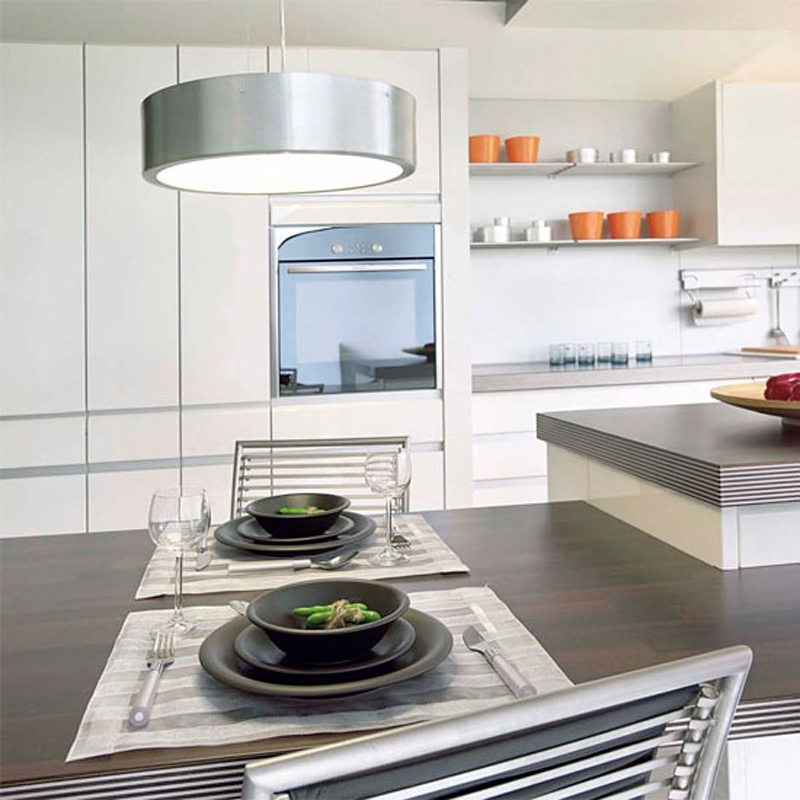
Ideas for using luminescent-type lighting in the kitchen interior
The area at the stove, sink, table - those work areas that require good lighting. If the fluorescent lighting for the kitchen will be framed in the form of an apron on the wall, then this can be an excellent way out. You can place it both on the ceiling surface and on the lower outer wall of the wall cabinets. If you use light bulbs with certain colors, you can add a touch of grace, harmony, showiness in the kitchen interior.
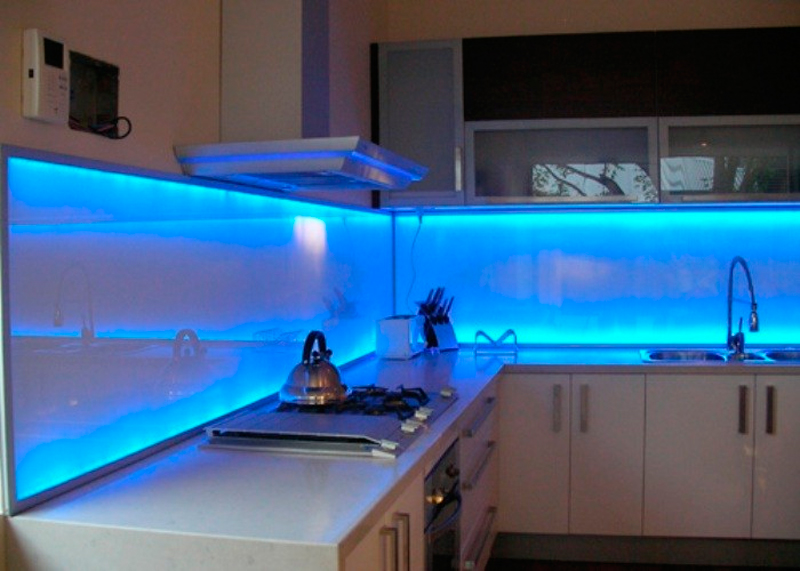
Another option for placing luminescent lighting elements is to mount them in a multi-tiered ceiling. For such a lighting model, raster or pendant fixtures are more suitable. Suspended lamps look harmoniously only on high ceilings, it is better not to use them in shaping the interior of a small kitchen.
If you need to arrange a small kitchen with hanging lighting elements, use models of lamps with the function of adjusting the suspension. This will allow you to vary the height of the lighting elements.
From the moment when the first incandescent bulbs appeared, more than a century passed. Progress does not stand still, and therefore now for lighting we are increasingly using not these devices, but their modern and more economical descendants. Fluorescent lamps are popular, which you can buy in Moscow in the Prestige stores.
Main advantages
Lamps of this type are one of the varieties of gas-discharge lamps, which has a number of fundamental advantages over conventional (incandescent):
- a big light efficiency, with the same power (40W fluorescent lamps shine much brighter than incandescent bulbs);
- long service life. Fluorescent lamps, the price of which is now not much more than the usual light bulbs, serve much longer .;
- the use of phosphor. This allows the use of fluorescent lamps to form light of a strictly specified spectrum. The color with which linear fluorescent lamps shine depends on the phosphor, which means that you can get a practically full spectrum of daylight or a fluorescent incandescent lamp (the spectrum will be similar to a conventional light bulb).
Energy saving fluorescent lamps e27
Due to their undoubted advantages, these lighting devices are widely used in public institutions, including medical and educational. Standard lamp in this case is a fluorescent lamp 36 and 40 watts. But in homes more often energy-saving lamps are used, having a standard base, mainly E27 and E14.
Saving first
Low energy consumption, lower electricity costs, a spectrum of light as close to daylight as possible - all these are advantages that you getfluorescent lamps. Buy Both energy-saving and ordinary modifications are possible, the effect will still be noticeable.18 W fluorescent lamp will allow you to reduce costs, get savings and at the same time provide sufficient illumination.
For example: professionals buying from us for offices and production premises fluorescent lamps e27 put them in the corridors with a constantly on lighting and get a solid savings.
Full product range
Our online store "Prestige" offers customers a full range modern lamps lighting. Of course, we also offer fluorescent lamps of all types. You can choose fluorescent 18w lamps of energy saving type, for office lighting. Our online managers will prompt you if necessary:
- which section of the store is the g5 fluorescent lamp;
- how correctly and in what luminaires the fluorescent lamp g13 is operated;
- give advice on the use of energy-saving lamps and their compliance with the luminosity of conventional incandescent lamps;
- they will tell you about the advantages of the Navigator lamps and help solve all other questions on your order, please contact us!
